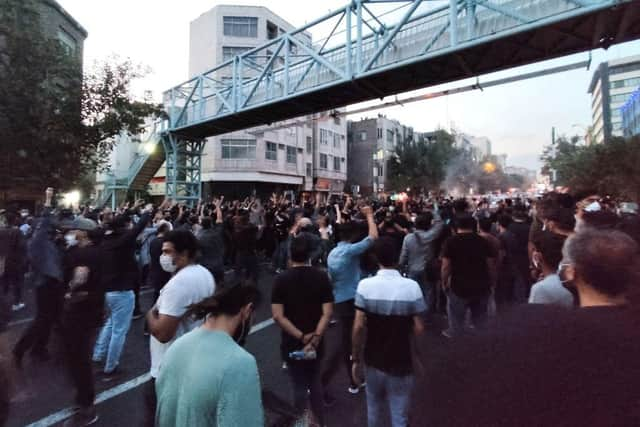Iran protests: How a woman’s death in police custody has sparked a wave of bloody protests
Seconds later, Ms Amini was arrested and bundled into a police van. It was the start of a tragic series of events which have sparked widespread, bloody protests across Iran in the worst unrest seen in the country for years.
Iranian state media says 11 people have died over the seven days of protests, which have seen women burning their hijabs and cutting off their hair in protest at the enforced wearing of the hijab head covering – and the resulting punishments for those who do not comply. However, activists claim eight protesters were shot dead on Wednesday night alone.
Advertisement
Hide AdAdvertisement
Hide AdThe Amini siblings, from Saghez in the Iranian province of Kurdistan, were leaving the Shahid Haghani Metro station in central Tehran last Tuesday evening when a patrol car of the branch of the Iranian police force known as the “modesty police” blocked their way.


The officers took Ms Amini, 22, to a “re-education centre”, allegedly on grounds her hijab was not being worn correctly. Hours later, she was admitted to hospital, seriously ill and died on Friday last week after spending three days in a coma. Her family believe she was beaten by police.
The protests have spread across the country, with much of the activity occurring in Tehran – as well as Ms Amini’s home province. Riot police, as well as plain-clothes security forces, used tear gas against demonstrators in the capital, with one woman saying her neighbourhood felt “like a war zone”.
Protesters are shouting anti-government slogans, including “down with the dictator”, something they are targeting at the Supreme Leader, Ayatollah Ali Khamenei, who has ruled the country since 1989.
Iranian authorities have now blocked access to apps like Instagram and WhatsApp. The limited internet accessibility is a bid to stop protesters from organising riots, but many fear it could result in increased brutality against protesters. In 2019, the government shut down the internet in the country entirely for a week in a bid to suppress civil protests.
The authorities have insisted Ms Amini was not mistreated – that she died of a heart attack while in custody. Their claims that she suffers from a range of underlying illnesses including diabetes have been rejected by her family.
The family has also insisted she was wearing a hijab and modest clothing. Video footage of her arrest circulating on social media appears to confirm that. The video, if authentic, appears to show police officers throwing Ms Amini to the ground with force and beating her, before taking her away.
“They have to explain for what crime, for what reason did they do this?” her mother asked in an interview on Iranian television. “I am her mother and I am dying from grief.”
Advertisement
Hide AdAdvertisement
Hide AdIn an interview with the BBC on Wednesday, Ms Amini's father Amjad said he was not allowed by authorities to see all of Ms Amini’s body before she was buried. He said he was only able to see her face, but not the back of her head, as well as her legs, both of which were bruised.
Ms Amini’s brother says he tried to intervene in his sister’s arrest, but his arm was twisted behind his back. After he disentangled himself, the officers told him they were taking Ms Amini to the station and that she would be released after a one-hour “re-education class”. He followed the car to the Vozara Avenue detention centre.
Mr Amini told local media site IranWire: "When I got to the front of the building, there were 60 or 70 people there carrying clothes for the detained women inside. After a few of them were released, we suddenly heard screams. All of us were banging on the doors.
"All of a sudden the agents rushed out of the building and attacked us with batons and tear gas. Five minutes later an ambulance left the building."
The authorities have claimed the protests were “organised” to “create disturbances”.
Mohsen Mansouri, the governor of Tehran, tweeted on Tuesday: “The main elements of the initial core of the gatherings in Tehran tonight were fully organised, trained and planned to create disturbances in Tehran.
“Burning the flag, pouring diesel on the roads, throwing stones, attacking the police, setting fire to the engine and garbage cans, destroying public property … are not the work of ordinary people.”
Iranian women have been required to wear a hijab since the 1979 Islamic revolution. However, since last summer, when Ebrahim Raisi was elected as president, enforcement has been even stricter.
Advertisement
Hide AdAdvertisement
Hide AdOfficers wait in busy public places to spot women who flaunt rules about covering their hair and disguising the shape of heir bodies in loose clothing. Many women who are stopped by the morality police are given a notice or, in some cases, fined.
Others, like Ms Amini, are taken to a re-education centre – the first of which was set up in 2019 – where they are usually given classes about Islam and the importance of the hijab, and then forced to sign a pledge to abide by the state’s clothing regulations before they are released.
In a rare criticism of the “morality police”, parliament speaker Mohammad Bagher Ghalibaf said on Tuesday the police unit's conduct should be investigated.
On Wednesday, Iranian leader Mr Khamenei. 83, spoke at an event commemorating veterans of the 1980-88 Iran-Iraq war.
The leader spoke for 55 minutes, but did not mention the protests, instead focusing on "the need to teach young Iranians about the conflict and for them not to fall for Western powers' deception".
Comments
Want to join the conversation? Please or to comment on this article.
